Deepak Kumar Nayak1, R. Murugan1, K. Selvakumarasamy1, S. Rama Reddy1, S. Sheik Aalam2
1Department of ECE, Aalim Muhammed Salegh College of Engineering, Muthapudupet, Avadi, IAF, Chennai-600055, India. 2Department of EEE, Jerusalem college of Engineering, Centre for collaborative research with Anna University, Pallikaranai, Chennai-600100, India.
DOI : https://dx.doi.org/10.13005/bpj/624
Abstract
DC/DC Converters play a vital role in biomedical imaging systems such as x-ray, ultra sound and Magnetic Resonance Imaging systems. These applications require low ripple voltage waveforms, low voltage spikes and variable output voltages. This paper presents a naturally clamped bidirectional secondary modulation based zero current switching (ZCS) current fed half-bridge DC/DC converter for biomedical imaging systems. The proposed bidirectional converter achieves zero current switching (ZCS) of the main switches at the primary side and zero voltage switching (ZVS) of the rectifier switches at the secondary side. In the proposed converter, the secondary modulation clamps the voltage across the main switches in the primary side naturally, so that voltage spike at the switch turn-off is not seen. The operation of the proposed converter is explained, analyzed, and the performance of the converter is implemented in MATLAB for a model of 20 kHz switching frequency and 20 W output power.
Keywords
Voltage fed inverter; current fed inverter; zero voltage switching (ZVS); zero current switching (ZCS); bidirectional converter
Download this article as:| Copy the following to cite this article: Nayak D. K, Aalam S. S, Murugan R, Selvakumarasamy K, Reddy S. R. Naturally Commutated Bidirectional Half-Bridge High Efficient DC/DC Converter for Biomedical Imaging Systems. Biomed Pharmacol J 2015;8(1) |
| Copy the following to cite this URL: Nayak D. K, Aalam S. S, Murugan R, Selvakumarasamy K, Reddy S. R. Naturally Commutated Bidirectional Half-Bridge High Efficient DC/DC Converter for Biomedical Imaging Systems. Biomed Pharmacol J 2015;8(1). Available from: http://biomedpharmajournal.org/?p=2109> |
Introduction
Commercial medical imaging systems employ either unipolar or bipolar pulse generators. Very high voltage ultra-short unipolar pulse signals are generated by unipolar pulse generators which are widely employed in many applications because of their ease of use and wide bandwidth 1. Due to high sensitivity, signal to noise ratio, and high efficiency, bipolar pulse generators are preferred over unipolar pulse generator 2, 3 but these are difficult to implement.
There have been many techniques that are employed for the generation of on-chip bipolar supply voltages. Comercial products developed in 4,5 generate a positive supply voltage by using a boost power converter, while such an implementation is simple, the use of additional bulky inductors, off-chip pins, I/O pads and multiple controllers lead to low efficiency, some amount of EMI noise and large system volume.
Current fed topologies have been used widely for applications with more input source voltage variations and for higher voltage conversion ratio 6-11. These converters give smaller input current ripple, no duty cycle loss and small diode ringing. For high voltage converters, these converters are very useful. Current fed bidirectional half- bridge DC/DC converter is analyzed in 12, where to absorb the serge voltage, active clamp circuit is used. Current fed bidirectional push-pull DC/DC converter is analyzed in 13, where the leakage inductance and the parasitic capacitance are utilized to achieve the ZCS but resonant current is much higher than the input current. So, there is increase in the current stress of the devices.
Generally bidirectional DC/DC converters are used for transfer of power in both forward and reverse directions. Current fed bidirectional DC/DC converters are very popular which gives small input ripple, small diode ringing, and no duty cycle loss 14-17.
The above literatures do not deal with natural clamp soft switched half-bridge DC/DC converter for biomedical imaging systems. The objective of this paper is to present the steady state operation, analysis, and implementation in MATLAB of the proposed converter in forward mode only. Although the converter can works in both mode, only forward mode has been presented here.
Operation And Steady-State Analysis Of The Proposed Converter
Fig.1 shows the proposed bidirectional half-bridge DC/DC converter. For the analysis of the converter, the following assumptions are made.
- Inductor L1 and L2 are assumed large because constant current should flow through both the inductors.
- The magnetizing inductance of the transformer is considered to be very large.
- Lk is the leakage inductance of the transformer or it is the external series inductor which also includes the leakage inductance of the transformer.
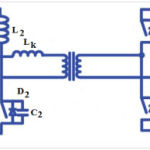 |
Figure: 1 Proposed bidirectional half-bridge converter |
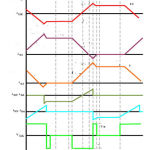 |
Figure: 2 Waveforms of the Proposed bidirectional half-bridge converter |
The steady state operating waveforms of the proposed converter is shown in Fig.2. Due to the symmetry in nature, only half cycle of the converter is explained here in eight intervals.
Interval 1 (t 0 to t1): In this interval, primary side switch S1 and body diode of S5 and S6 (D5 and D6) are conducting. Positive power is transferred from source to load in this interval. At the end of this interval,
![]()
Where I=input current
n= transformer turns ratio.
Interval 2 (t 1 to t2): In this interval, at t=t1, S2 is turned on. So, the snubber capacitor of S2, (C2) discharges quickly.
Interval 3 (t2 to t3): In this interval, current through (S2), starts increasing and current through S1, starts decreasing. The current in S2, starts from zero provides ZCS turn on for switch S2, which reduces losses at S2. The current through several components are,
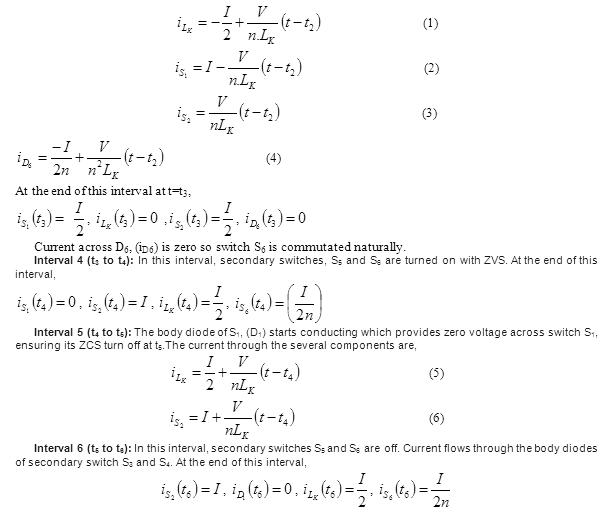
Interval 7 (t6 to t7): In this interval, the capacitance of S1, (C1) charges to V/n.
Interval 8 (t7 to t8): In this interval, constant current is flowing through the switch S2, secondary leakage inductance LK and body diode of secondary switch. For the next half cycle, the intervals are repeated.
Simulation Results
The proposed converter is simulated by MATLAB simulink. The specifications and the component values of the simulink model are shown in Table 1.
Simulink output of the proposed converter is shown in Fig.3. Gating signals for S1, S2, S3, S4, S5, and S6 are shown in Fig. 3(a). It is observed that, conduction time of the primary side main switches S1, and S2 are equal and 180 0 phase shift with each other. The conduction time of S3, S4, S5, and S6 all are same and the duty cycle is less than 50%.
Fig. 3(b) shows, gate to source voltage (Vg2), drain to source voltage (Vd2), and current through the switch S2, (iS2). We observe that, gate to source voltage (Vg2), falls to zero, and after that, drain to source voltage (Vd2), starts rising. The current across the switch S2, naturally reduced to zero, and negative current shows that, antiparallel diode conduction across the switch. So, primary side main switch is turn off at ZCS.
Fig. 3(c) shows voltage across the primary (VPri), voltage across the secondary(VSec) and current across the secondary (i Sec) of the transformer. We observe that, the current through the secondary is almost continuous. We also observe that, input and output voltage across both side of the transformer is without ringing and spikes.
Fig. 3(d) shows the gate to source voltage of S3, (Vg3), drain to source voltage of S3, (Vd3), and current across the switch S3, (iS3).We observe negative current across the switch, which is due to the body diode conduction. Due to negative current, voltage across the switch (Vd3) is zero and the gate signal Vg3 is applied. So, secondary side switch S3 is turned on at ZVS.
Fig.3(e) shows the output voltage (V) and output current iOut, at a load resistance of 5Ω.
Fig.4 shows the measured efficiency with different load for the proposed converter in the MATLAB simulink model. The maximum efficiency of 92.99% for 11.89W and full load efficiency of 91.53% for 19.86 W are obtained. So, we observe that, although efficiency decreases at higher load, but over a wide load range, the efficiency curve remains almost high and flat.
Table 1: Specifications and component values
| Specifications | Component values |
| Input voltage Vin =48 V | Input inductance L1=1 H |
| Output voltage V=12 V | Input inductance L2=1 H |
| Switching frequency f= 20 KHz. | Primary inductance LK=5 µF |
| Power P= 20 W | Filter capacitance C= 500 µF |
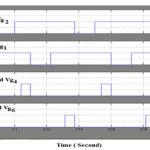 |
Figure 3 (a) |
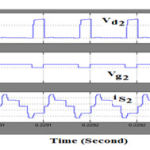 |
Figure 3 (b) |
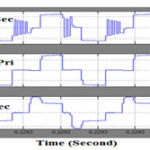 |
Figure 3 (c) |
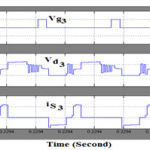 |
Figure 3 (d) |
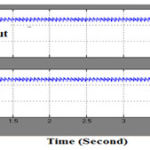 |
Figure 3 (e) |
Fig. 3 Simulation waveforms. (a) Driving pulses of S1, S2, S3,S4, S5, and S6. (b) Gate to source voltage (Vg2), drain to sourcevoltage (Vd2), and current through the switch S2, (iS2) (c) voltage across the primary (VPri), voltage across the secondary(VSec) and current across the secondary (i Sec) (d) gate to source voltage of S3, (Vg3), drain to source voltage of S3, (Vd3), and current across the switch S3, (iS3) (e) output voltage (V) and output current IOut
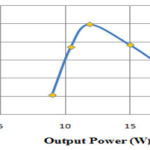 |
Figure: 4 Efficiency versus output power for different load condition |
Conclusion
This paper presents a soft switching bidirectional current fed half-bridge DC/DC converter for biomedical imaging systems where low ripple voltage waveforms, low voltage spikes and variable output voltages is required. The primary side switches are naturally voltage clamped and it causes ZCS. The secondary switches are naturally voltage clamped and it undergoes ZVS. Due to secondary modulation method, without any extra snubber circuit, primary side clamping takes place naturally. The proposed converter is independent of duty cycle and it works in both directions with high efficiency. The conversion of 48 V to 12 V is done by taking different loads. It has found that, the proposed converter has high efficiency and it can be used in biomedical imaging system applications due to ripple free output,very simple design and high efficiency.
References
- Qiu, Y. Yu, F.K. Tsang and L. Sun, “A multifunctional, reconfigurable pulse generator for high-frequency ultrasound imaging”, IEEE Transactions on Ultrasonics, Ferroelectrics, and Frequency Control, Vol. 59, No. 7, pp. 1558-1567, Jul. 2012.
- Sun, X. Xu, W.D. Richard, C. Feng, J.A. Johnson and K.K. Shung, “A high-frame rate duplex ultrasound biomicroscopy for small animal imaging in vivo”, IEEE Transactions on Biomedical Engineering, Vol. 55, No. 8, pp. 2039-2049, Aug. 2008.
- Rajdeep Bondade, Yikai Wang, Student, Dongsheng Ma,” Design of Integrated Bipolar Symmetric Output DCDC Power Converter for Digital Pulse Generators in Ultrasound Medical Imaging Systems”, IEEE Transactions on Power Electronics, vol.29(4),pp.1821-1829,2014.
- LT1945 Dual micropower DC/DC converter with positive and negative outputs, Linear Technology Corporation. [Online]: www.linear.com
- TPS65130/TPS65131 Positive and negative output DC-DC converter, Texas Instruments, Sept. 2004. [Online]: www.ti.com
- K. Rathore, A. K. S. Bhat, and R. Oruganti, “Analysis, design, and experimental results of wide range ZVS active-clamped L-L type current-fed DC/DC converter for fuel cells to utility interface,” IEEE Trans. Ind. Electron., vol. 59, no. 1, pp. 473–485, Jan, 2012.
- J. Jang, C. Y. Won, B. K. Lee, and J. Hur, “Fuel cell generation system with a new active clamping current-fed half-bridge converter,” IEEE Trans. Energy Convers., vol. 22, no. 2, pp. 332–340, Jun. 2007.
- Song and B. Lehman, “Current-fed dual-bridge DC–DCconverter,” IEEE Trans. Power Electron., vol. 22, no. 2, pp. 461–469, Mar. 2007
- Averberg, K. R. Meyer, and A. Mertens, “Current-fed fullbridge converter for fuel cell systems,” in Proc. IEEE PESC, 2008, pp. 866–872.
- -T. Kim, B.-K. Lee, T.-W. Lee, S.-J. Jang, S.-S. Kim, and C.-Y.Won, “An active clamping current-fed half-bridge converter for fuel-cell generation systems,” in Proc. IEEE PESC, 2004, pp. 4709–4714.
- J. Wolfs, “A current-sourced DC–DC converter derived via duality principle from half bridge inverter,” IEEE Trans. Ind. Electron., vol. 40, no. 1, pp. 139–
144, Feb. 1993. - Jang S. J., Won C. Y., Lee B. K. and Hur J. Fuel cell generation system with a new active clamping current-fed half-bridge converter. IEEE Trans. Energy 2007, 22(2), 332-340.
- Chu C. L. and Li C. H. Analysis and design of a current-fed zero-voltage switching and zero-current-switching CL-resonant push-pull DC–DC converter IET Power Electron. 2009, 2(4), 456-465.
- Xuewei P. and Rathore A. K. Naturally Clamped Zero-Current Commutated Soft-Switching Current-Fed Push–Pull DC/DC Converter: Analysis, Design, and Experimental Results. IEEE Trans. Power Electron. 2015, 30(3), 1318-1327.
- Rathore A. K. and Prasanna U. R. Analysis, Design, and Experimental Results of Novel Snubberless Bidirectional Naturally Clamped ZCS/ZVS Current-Fed Half-Bridge DC/DC Converter for Fuel Cell Vehicles. IEEE Trans. Power Electron. 2013, 60(10), 4482-4491.
- Bal S., Rathore A. K. and Srinivasan D. Modular Snubberless Bidirectional Soft-Switching Current-Fed Dual 6-Pack (CFD6P) DC/DC Converter. IEEE Trans. Power Electron. 2015, 30(2), 519-523.
- Yang J. W. and Do H. L. Soft-Switching Bidirectional DC-DC Converter Using a Lossless Active Snubber. IEEE Trans. Circuits and Systems. 2014, 61(5), 1588-1596.








